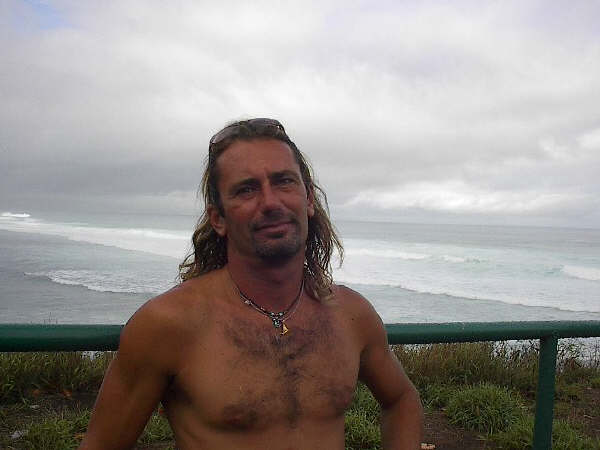

Because of the proximity of the source, all kind of periods were in the water and unless you had some kind of natural or artificial land configuration that would filter some of them out, everywhere else was pretty horrible.
Here's a couple of shots from Jimmie Hepp when Honolua cleaned up a bit. You can still see the rawness of the power in this one that shows surfer Joao Marco Maffini.

This guy is about to feel it too.

Here's an interesting abstract of Pat Caldwell's three times a week meteo poetry:
Relative to historic giant episodes of the last 50 years, the occlusion point for the 2/22 episode was the closest. The system formed west of the dateline 2/19. It raced east as it intensified, crossing the dateline Saturday and occluding near 33°N, 159°W near 00Z 2/22 gmt, or 2 pm HST 2/21. Deepest pressure dropped to 964 mb at the occlusion point, which coincides with a stalling of the storm track, a maximum in ocean surface winds, and a broadening of the gyre. For winds aimed at Hawaii, hurricane-force winds covered a 600 nm fetch with the head about 600 nm away on Sunday. Severe gales reached to 28°N, with gales to near Hawaii, as recorded by the NW Hawaii NOAA buoys. Proximity makes for large wave heights and an elevated wave spectrum, meaning high wave energy from the short- to long- wave period bands, giving way to less organized breakers and more frequent arrival of higher wave groups.
The second closest occlusion point for giant surf locally happened 30 years ago in 1986, nearly to the day. Buoy 51001 registered 31 feet at 20 second intervals on 2-23-1986. Similarly, 51001 measured 31 feet at 16 seconds 2-22-2016.
Similarly, but not so similarly. 4 seconds in the period make a big difference when the waves will break. How much difference? I just read this interesting article about the correlation between size and period of a swell and size of the waves when they break. Even though I'm not a big fan of generalization in this matter, I have to say that most of those values are pretty accurate.
The example they use, for instance, is good. I've surfed 6f 14 from NW at Hookipa countless times in the last 15 years (always checking the buoys) and I would say it's head and a half to DOH. And that's what 7.5 to 10 feet is, I guess. I still like body parts better.
At the same time (well not literally), in the same category 3, I also surfed 4f 20s at a spot on the south shore and there were solid triple overhead waves, which is obviously more than that. So it depends a lot on the break.
But I do like the fact that they succeed in transmitting the main concept that a whatever size wave can be generated by an extremely wide variety of combination of swell sizes and periods.
--------------- BUOYS ------------------
The swell peak readings were 25f at the NW and Waimea buoys, 20f at Hanalei (not in the graph), 18 in Maui. While I can try to justify the 18 in Maui as due to the rapid decay of a closely generated swell, the 20f at Hanalei don't make any sense. The only thing that will justify them is: those buoys don't measure the swells in the same way.
The one thing that was confirmed instead, is the time when the swell peaked in Maui: noon. That confirms the validity of GP's rule of thumb: 12h at 18s, 18h at 12s. I'll carve it with a scalpel on a rock at Hookipa, or maybe I should print some shirts with it written on.
Anyway, the swell is on the way down compared to yesterday, but with 13.1ft @ 15s from 326° (NW) and 6.0ft @ 11s from 330° (NW) still at the Pauwela buoy, I wouldn't call it small just yet...
It should turn a little more northerly as the day progresses (more so tomorrow). I put an arrow on the direction line of the NW buoy in the graph below, to illustrate that subtle change.

Wind map shows the two lows starting to form one big enormous gyre. The fetch of it shooting at us is pretty strong today. Giant surf again on Thursday.

It's with great joy that I announce that MC2km maps are back online. Not updated while I write this, but you guys can check them later. In the meantime, I'll stick to this 11am forecast on Windity that shows very light ENE wind. Not enough for sailing.

The Eddie has a yellow alert for Thursday.









No comments:
Post a Comment